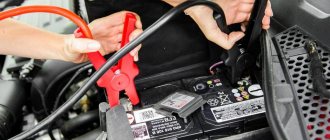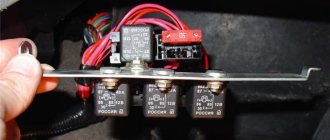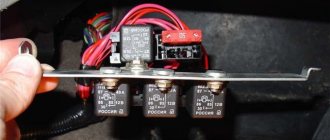With a new battery, problems rarely occur, especially if it is maintenance-free. Therefore, the need to remove it rarely arises. Still, even such batteries require periodic charging, and this operation requires care when connecting the charger. If there are usually no problems with installing a battery on a car, then when charging the probability of mixing up the wires is not so small. How dangerous is such a mistake, and what will happen if you make it while lighting a cigarette from another battery?
Confused battery terminals: possible consequences
The simplest answer to the question of what will happen if you mix up the terminals of a car battery is short: don’t expect anything good. In the most optimistic scenario, you will have to change the fuses, but often the consequences are much worse. Let's list them.
Closure
The first thing you need to understand is that polarity reversal (this is not quite the correct term, but it reflects the essence of the problem correctly) is a short circuit. And it is always accompanied by visual and sound effects that are impossible to notice: sparks, characteristic clicks, and smoke is not excluded.
If you have a very good reaction, all of the following problems can be avoided by simply withdrawing your hand with the wire. Alas, this does not always happen. So, read on.
Ignition, fire
The most catastrophic scenario occurs if the driver “fell into a stupor” after a hail of sparks began to fall from the terminals after an incorrect connection. Polarity reversal is essentially a short circuit in which the wires begin to heat up, melting the braid. Insulation is not always non-flammable, and if at the point of short circuit the wiring passes close to other flammable materials or comes into contact with technical fluids, the risk of fire increases manifold.
In such cases, you need to act quickly, avoiding a long-term short circuit due to incorrect connection of the wires. If these are charging wires, you can unplug the charger from the socket - this will be safer than resetting the terminals.
Battery power drop
If you mixed up the battery terminals not on the car, but when you put the battery on charge, then the problems will be localized only by the battery itself and the charger.
If the battery was completely discharged, then connecting it with reversed wires will lead to charging, during which its terminals will change polarity - positive will become negative and vice versa. This procedure is called polarity reversal. In some cases, it is used purposefully, but a drop in battery capacity cannot be avoided.
Another thing is an error with the wires regarding a partially charged battery. Here, most likely, the charger will suffer, and irrevocably. Due to a short circuit.
ECU failure
If a car fire should be considered a catastrophic scenario, since in this case you lose your vehicle, then a burnt-out on-board computer is the second most serious problem. A modern passenger car cannot operate without an electronic control unit, and the unit itself is an expensive thing. Loss of settings is another consequence of a burnout of the BC electronic unit.
Blown fuses
This is the most optimistic option (in terms of money, of course). But, to be honest, you shouldn’t hope that everything will work out just by replacing the fuses. Even if you have a good reaction, before the increase in current burns out the wires designed for a certain resistance, electronics sensitive to voltage changes may suffer.
However, problems can arise with blown fuses, since it is not always possible to immediately determine what exactly is not working. So, in the event of force majeure caused by your mistake in connecting the battery, do not be lazy before the trip to check the functionality of all consumers.
Generator failure
If you mix up the battery terminals, the first person to know about it will be the generator. True, it is well protected against such errors by the presence of a diode bridge, but there are models (mostly outdated or very cheap) where it is missing, and then the generator is the first to be exposed to a short circuit and burns out.
Alarm failure
Since the alarm is usually connected directly to the battery, the likelihood of it burning out is quite high. Especially if its design provides for the presence of triggers - they do not tolerate polarity changes.
Partial melting of wires
We have already mentioned this problem - due to a short circuit, a current begins to flow through the wires in excess of the permissible value. The resistance increases, the metal heats up quickly, and the insulation melts. So you made a mistake - be sure to check the integrity of the wires.
Consequences of incorrect battery connection
Let’s immediately dispel the myth that a battery connected “backwards” starts the engine in the opposite direction. Let's start with the starter: if the stator has a winding and not permanent magnets, then when the polarity is reversed, the direction of the current will change simultaneously in both the stator and the rotor, the starter will begin to rotate in the same direction as before. Think about the commutator motors of electric drills, grinders and other tools - they operate on alternating current, the direction of which is constantly changing.
A starter with permanent magnets on the stator will indeed begin to rotate in a different direction, but will not be able to crank the engine. Bendix will not allow force to be transferred in the “wrong” direction, that’s what it is designed for.
Even if you managed to spin the engine in the opposite direction, the four-stroke engine begins to take air from the exhaust manifold and throw exhaust gases into the intake manifold. So neither a carburetor nor an injection engine can be started this way, unless a diesel engine with a mechanical injection pump starts.
If the driver reverses the polarity of the battery during installation, then one of the most serious consequences will be that the generator will definitely suffer. Look at the diagram of its diode bridge (using the example of the simplest “Zhiguli” circuit):
A semiconductor diode is an element with one-way conductivity; it is not for nothing that its symbolic image looks like an arrow. It conducts current in the direction of this “arrow”, but not in the opposite direction. When the battery is connected correctly, then while the generator is not working (the voltage on its windings is less than the battery voltage), the diodes are locked - for the battery, the generator is a load that consumes several milliamps due to the presence of a small reverse current in the diodes.
If you mix up the terminals on the battery, the diodes in the bridge will open and the battery will be short-circuited through them. This will lead to overheating of the diode bridge and failure of the diodes with a characteristic odor and popping noise due to the destruction of their cases.
Burnt out generator diode bridge
But polarity reversal is not always harmful for on-board electronics. Any electronic device, if it was not assembled by Chinese children in labor lessons, has protection against polarity reversal. It is simply implemented using the same diodes: here they are open when connected “correctly”, and when connected “incorrectly” they cut off the load from the on-board network. However, diodes along the power supply circuit are rarely used in powerful current consumers - radio tape recorders and amplifiers. And they contain elements that are extremely vulnerable to polarity reversal - electrolytic capacitors, installed to smooth out voltage ripples precisely in the power circuits.
Electrolytic capacitors have a high specific capacitance and are therefore popular in electronics. But their weak point is that they work only at a certain polarity of the voltage on the plates; when the polarity is reversed, heating occurs, abundant gas evolution occurs (the capacitor swells), then an explosion. The larger the capacitance and dimensions of the capacitor, the stronger all this is - if a capacitor of a few microfarads clicks slightly, then the “cans” of thousands of microfarads used in amplifiers explode.
Failed capacitors
And a lot of relays in the wiring can make the same sound as the diodes in the alternator bridge. The fact is that in the windings of electromagnetic relays, when the voltage is turned off, a sharp surge of voltage occurs, which has reverse polarity relative to the power source. To eliminate the harmful effects of such pulses on the operation of sensitive electronics, it is customary to use diodes connected in the reverse direction. While voltage from the on-board network is applied to the winding, the diode is locked, and when the winding opens, it opens with an inductive surge pulse and extinguishes it. When the battery polarity is reversed, such diodes will burn out.
If you mixed up the terminals when charging a car battery
This is usually what happens. The fact is that when installing the battery in its original place, it is unlikely that you will connect the wires incorrectly, even if you reverse the polarity - the positive and negative terminals have different diameters.
Another thing is connecting the charger to the battery. Crocodiles do not differ in size, and the possibility of getting the wires mixed up, although small, does exist.
If you realize quickly enough that you were wrong, the consequences can be avoided. Otherwise, there is a risk that the charger will burn out. In the event of a deep discharge of the battery, incorrect connection threatens polarity reversal, that is, a change in the polarity of the terminal terminals. If the design of the battery allows it to be used in this form, you can try, but you should always remember about polarity reversal.
It’s better to return the battery to its normal polarity by completely discharging it (be sure to slowly!) and charging it with the normal polarity of the wires connected. Of course, the most dangerous thing in this case is a deep discharge. For some types of batteries (for example, calcium batteries), this procedure is extremely undesirable.
The use of homemade chargers is permissible if they are equipped with a fuse that will protect against burnout of the charger. Most factory devices have such protection.
However, this does not apply to cheap Chinese chargers. If you mix up the battery terminals when charging, they most likely will not withstand such abuse.
Short circuits in the network
What happens if you short the battery terminals? Given the ability of starter batteries to briefly deliver current of hundreds of amperes, an object that shorts the terminals (for example, a wrench accidentally caught between the “plus” and the car body) will melt. More massive metal objects can become tightly welded to the terminals or body, causing the battery to go “zero.” At risk are cars where the battery is installed in the trunk - you should not carelessly throw keys or towing lugs there, it is unknown where they will end up under the influence of shaking while driving.
Battery short circuit when hit by a foreign object
Since such short circuits occur hidden from the owner (a key accidentally dropped during repairs can at least be immediately seen), they are the most dangerous - there is a high probability of ignition in the trunk.
If you mixed up the battery terminals when lighting a cigarette
Such an operation as lighting a “dead” battery from a charged one is quite rare. But it is fraught with many dangers for both the donor and the acceptor.
The fact is that if the wires are connected in series and incorrectly, we will be dealing with a short circuit with a rating of 24 V, and not 12. If you use low-quality wires of small cross-section, they will most likely simply burn out in the place where there is the most significant reducing their diameter. As the cross-section increases, the likelihood of wire burnout decreases. At least this will be preceded by a process of rapid heating, but here the likelihood of a fire increases.
So be careful when connecting wires, especially non-factory ones (the latter are color coded). It is important that the positive terminal of the donor battery is connected to the same positive terminal on the discharged battery, and this wire is connected first (first the crocodile clings to the car that needs to be started).
After successfully lighting the cigarette, it is equally important to follow the correct order of disconnecting the wires: first the negative one, and only after that the positive one.
Remember that you should resort to lighting only if there is no other choice - this procedure is very dangerous for on-board electronics due to inevitable power surges.











